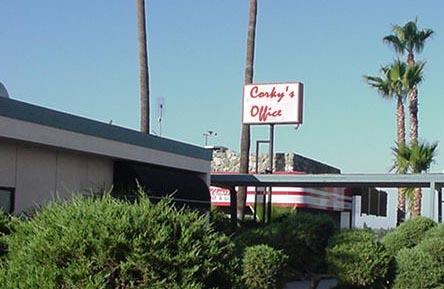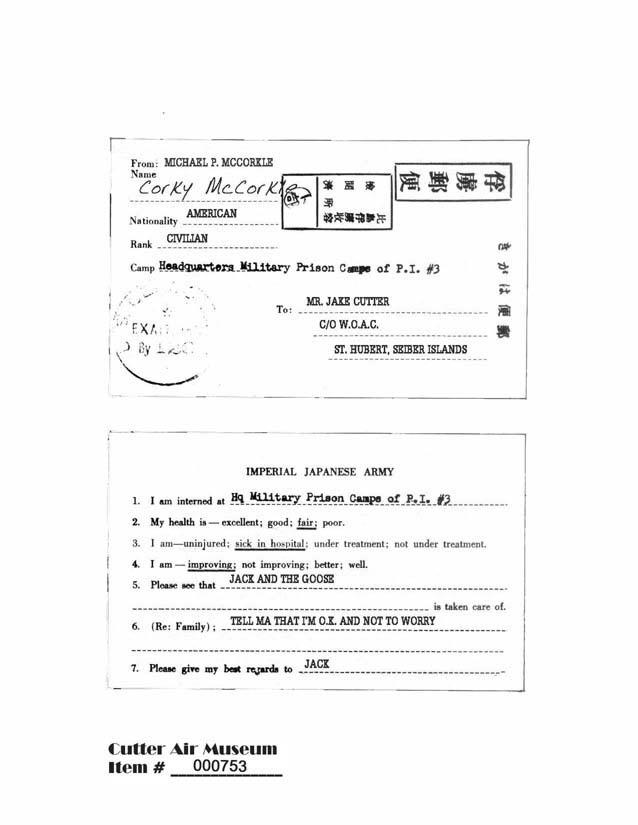Notice: Use of this site constitutes your
acceptance of these Terms of Use.
|
(Musée
d'Air de Cutter) St Hubert, the Seiber Islands The Corky McCorkle Exhibit |
|
|
|
|
|
NEW!! The
Museum are also pleased to
announce that cataloguing is almost complete on the
virtual cornocopia of
materials discovered six months ago in an old conex container behind “Corky's Office”. Although
it was originally thought that the materials would be
limited to "Corky Memorabilia", a number of
boxes--apparently given to Corky at some point for
safekeeping--belonged to such other notables as Jake
Cutter and Quinton McHale. Despite their years of
storage, most of the materials are in remarkably good
condition and will undoubtedly be of inestimable value
to historians. Due to space
limitations at Corky's
Office, a new exhibit showcasing these materials is
being prepared at the St
Hubert Hangar.
Please check this site for news of its opening. In
the meantime, some of the materials may be viewed here. |
|
A special part of the
Cutter Air Museum is the Corky McCorkle Exhibit
located in what is a pub adjacent to the Cutter Air
Terminal known as "Corky's
Office".1
Among the many artifacts
on display at Corky’s
Office is Jake Cutter's jacket , Jack's famous glass
eye and eyepatch, and the
following postcard that Corky sent to Jake Cutter soon
after Corky arrived at the Bilibid
Prison Hospital in the Philippines with a boatload of
British and Dutch prisoners on August 24, 1944: |
|
|
|
The Museum hope to soon
obtain Corky's
handwritten memoires, which were the basis of many of
the episodes of the 1980's American televison series, Tales of the
Gold Monkey. For
additional materials on display at Corky's Office, click
here. |
|
1 The pub was named after the
original “Corky’s Office”,
which was located in one of the Museum’s USAF Consular Support Buildings.
This is the “official” story of how the office got its
name: After Corky
McCorkle’s release from a Japanese POW camp and return
to the Seiber Islands,
Jake Cutter made him Chief of Maintenance and
Operations of the Seiber
Islands Division of WOAC (now Seiber Airlines). In early 1946, Jake regretfully
asked Corky to step down as M&O Chief and, still
reporting directly to him, take charge of the
Division’s “reserve” aircraft. Corky was assigned a small
crew of mechanics and an unused hanger and couple of
other temporary buildings which had been built and
used by the U.S. Army Air Corps
during WWII. Fortuitously, their first
task involved a WOAC Branta—a plane very similar to Cutter’s Goose
—and Corky proved not only that he had lost none of
pre-war skills as a hands-on mechanic, but could be
an effective leader as well. The original “Corky’s Office” was, in
fact, just his office.
But it did just happened to be in the same
building as what had been the American’s Officers’
Club. During
the late 1940’s and 1950’s, the old Club was
occasionally used by Corky and his employees as a
place to have a short celebration on the successful
conclusion of a difficult project. It also
became the place to store and display various
“artifacts” recovered from aircraft they had worked
on, e.g., a propeller from Cutter’s Goose
and a brass monkey found stuffed in a space in the
aft of Cutter’s
Goose which appeared identical to the one in
the famed Monkey
Bar. In
1966, Corky retired from WOAC, just after overseeing
the construction of new maintenance facilities at
the airport. Upon
retirement, he joined the Seiber
Islands Aero Museum (now the Cutter Air Museum),
becoming its first Chief of Aircraft Maintenance and
Restoration. Jake
arranged to have the U.S. buildings (along with
their artifacts, equipment, as well as a number of
WOAC’s “reserve” aircraft) transferred to the Aero
Museum at that time. |

